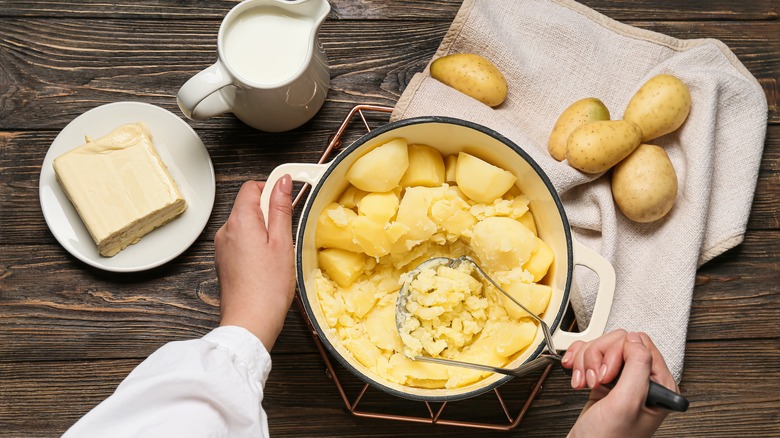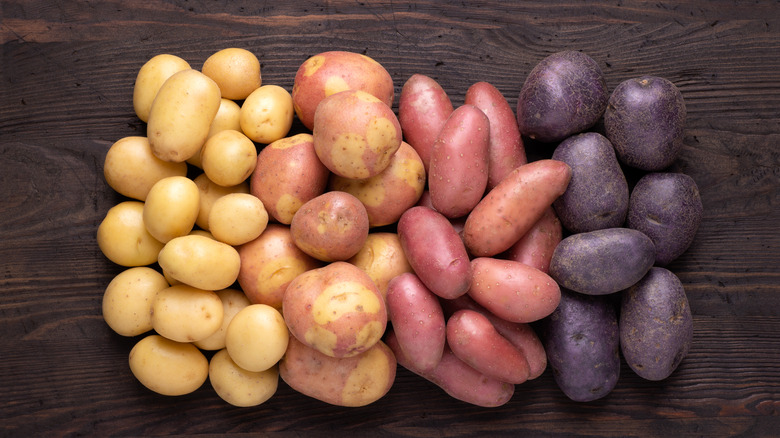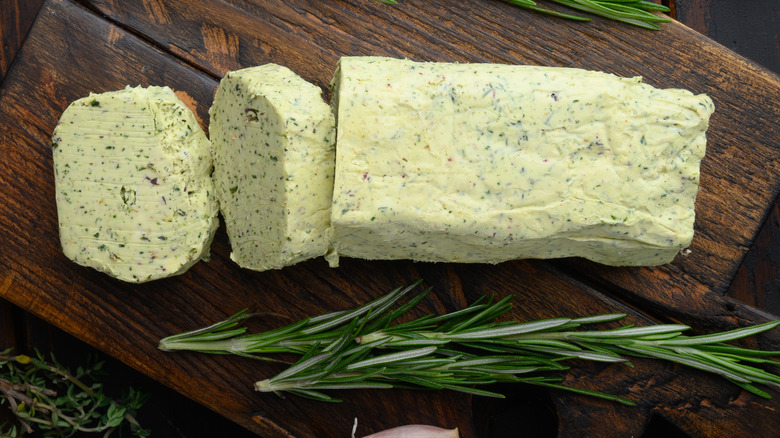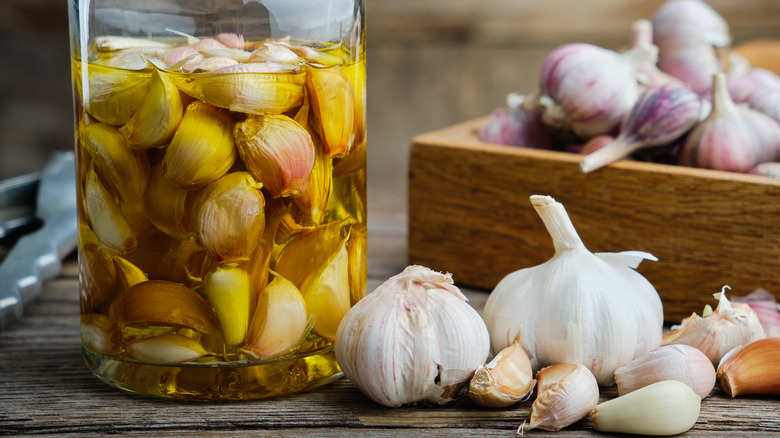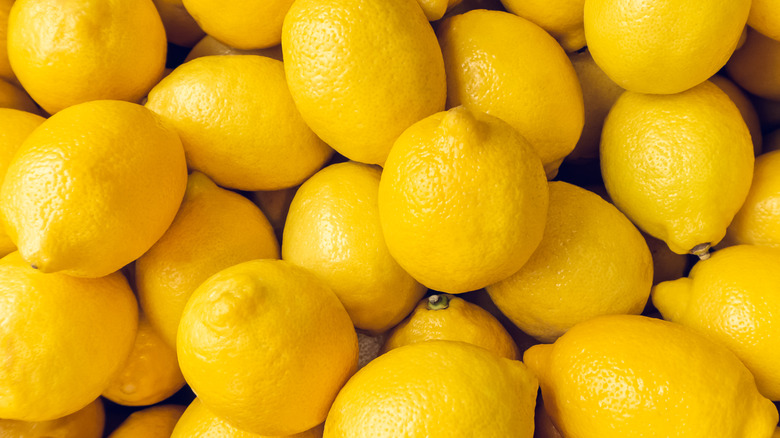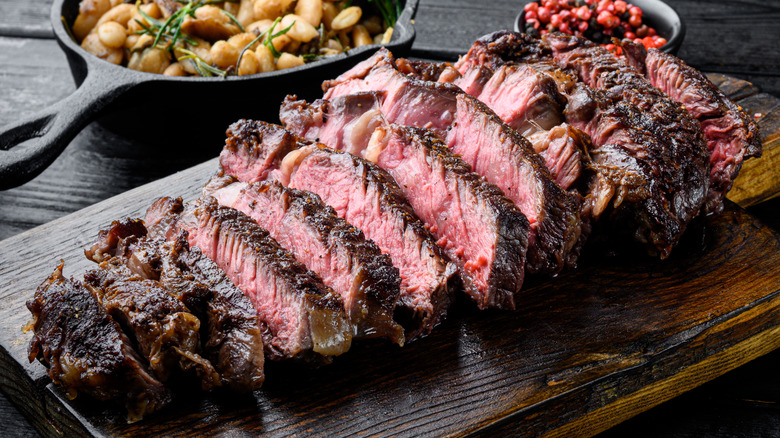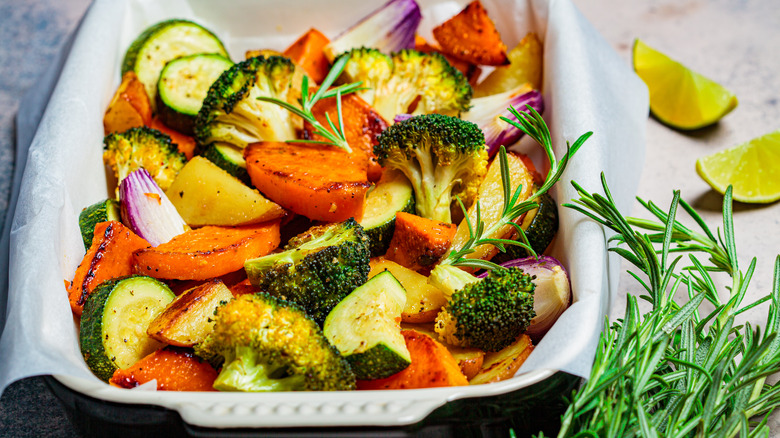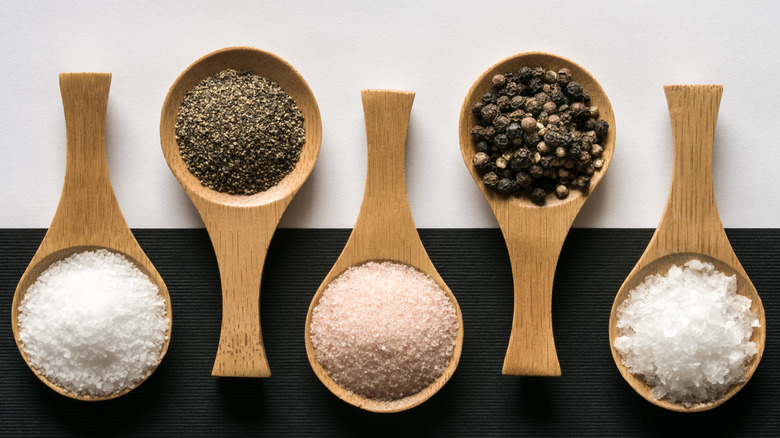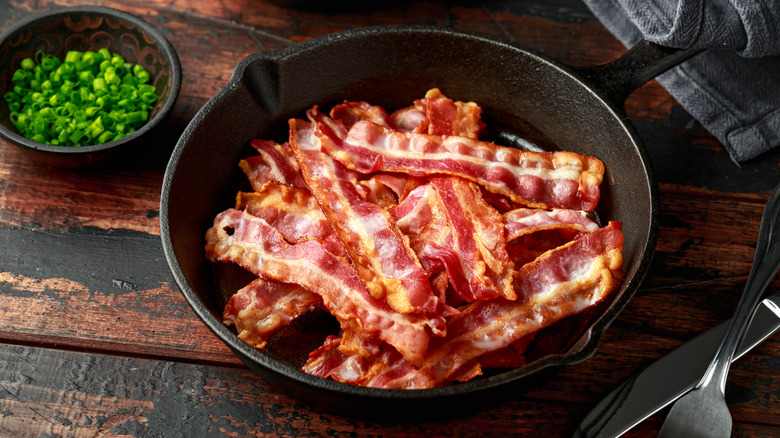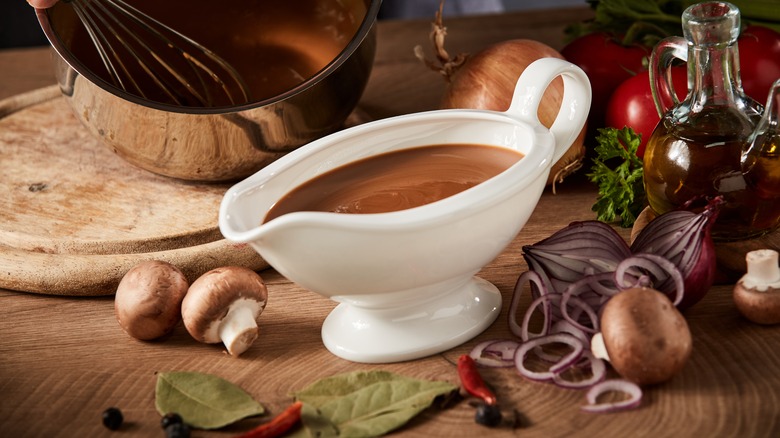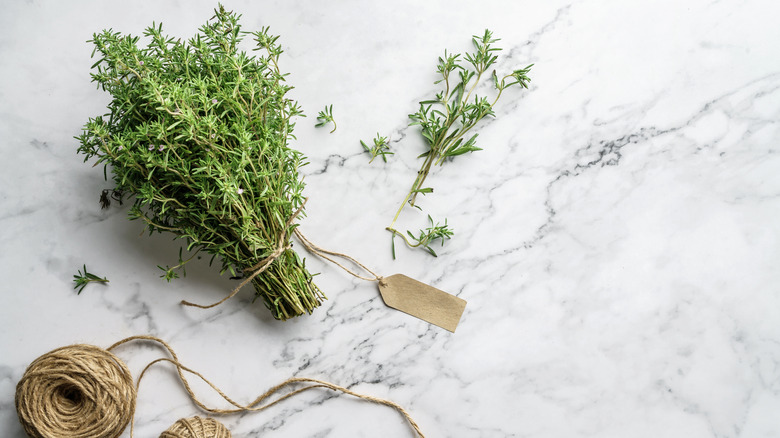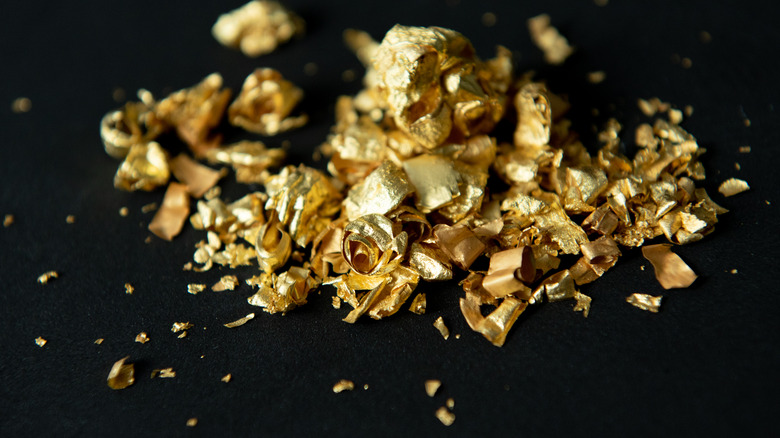The Ultimate Guide To Mashed Potato Bars
With the wide variety of food allergies, dietary restrictions, and nutritional choices around today, planning a menu for a party or special event can be a downright nightmare. How are you supposed to create a bill of fare that accommodates your aunt's keto diet, your brother's picky eating habits, and your grandma's seafood allergy all at the same time — and without sacrificing quality?
Enter the build-your-own bar. Whether it's a self-serve burrito station for Taco Tuesday, an ice cream sundae buffet for a wedding reception, or a snazzy champagne bar for New Year's Eve, build-your-own bars have taken the world by storm — and for good reason. The world we live in is all about choices, and build-your-own bars take customization to the next level. They allow guests to take a piece of food that might be unremarkable on its own and turn it into whatever their imaginations fancy. One of the most fun foods to transform into a build-it-yourself buffet is an inexpensive American classic: rich, creamy mashed potatoes.
There's a wide breadth of possibilities when it comes to potato puree — from selecting the spuds and creative serving vessels to decking out your mash with toppings du jour. The versatility of potatoes means they can be savory, sweet, spicy, or anything in between — it's all up to you. Behold: the ultimate guide to mashed potato bars.
Offer different types of potatoes
Yukon gold potatoes are considered the gold standard for traditional mashed potatoes (though some folks swear by Russet), but no one's going to complain if you liven up your buffet with a few different spud varieties. First off, if you know you'll have guests who don't eat dairy, providing a dairy-free mashed potato variety — either on its own or in addition to a standard mash — will be much appreciated. No one wants to miss out on the fun of a build-your-own bar, and there are plenty of ways to cook mashed potatoes that don't involve dairy of any kind.
Want to take things a little further outside the conventional box? Sweet potatoes are nutritional powerhouses, with one serving (1 cup, raw) providing 12% of recommended daily potassium and 16% of recommended daily fiber, per the USDA — they also happen to mash up quite nicely. They pair well with many mashed potato bar additions, but can also serve as a dessert item (just sprinkle on a little cinnamon sugar or marshmallow fluff).
Alternatively, you can offer a low-carb option: mashed cauliflower. Cauliflower has become the darling of healthy eating in recent years, and for good reason — it's low in carbs (5 grams per ½ cup, according to Carb Manager) but even richer than sweet potatoes in potassium, fiber, and protein. If cooked and seasoned in just the right way, mashed cauliflower can taste just as good as mashed potatoes.
Get creative with serving vessels
There's no law that says mashed potatoes must be served from a plate or bowl — we checked. So when deciding on the primary receptacle for your mashed potatoes, let your creative flag fly. If you're laying out your pomme puree bar at an upscale event like a wedding or reception, martini or wide-mouthed wine glasses are a classy way to go.
Another great thing about mashed potatoes is that they're not strictly for fancy occasions. Consider offering guests bread bowls a la Panera, or making up some cute and functional bacon cups. For those who want to up their veggie intake, offer the option of mashed potatoes over a bowl of greens or grains (think peppery arugula, bitter kale, earthy quinoa, or nutty farro). If you've decided to serve mashed sweet potatoes as a dessert option, graham crackers, warm cookies, and waffle cones are sure to impress. You can also offer crackers, toasted pita, crusty bread, or even crudité in place of spoons or forks.
Bear in mind that if you're using standard plates, bowls, and silverware, you'll need to ensure that you're keeping dishes sanitized for guests. If there aren't enough plates and silverware to go around, make absolutely certain that serving items are scrubbed with dish soap and washed with hot water in between each use.
Top your taters with compound butter
Compound butter is not your grandmother's butter. Although butter (or dairy of any kind) isn't necessarily a must-have ingredient, it plays a role in both the texture and flavor of classic mashed potatoes. Topping your smashed spuds with compound butter takes your dish to a whole new level.
Compound butter is just butter mixed together with flavorful seasonings. It's extremely easy to make and allows for endless savory (or sweet!) combinations. Simply take room temperature unsalted butter and mix in herbs, lemon juice, hot peppers, cinnamon sugar, or whatever else you'd like to infuse the butter with. You can use a stand mixer, hand mixer, or even just a bowl and fork — all you need to do is whip the ingredients together. A straightforward garlic-and-herb compound butter will take your traditional potato puree from "meh" to "wow," while a compound butter infused with baking spices like clove and brown sugar will bring out the natural sweetness of mashed yams. Try this chipotle and roasted garlic compound butter to add a little kick to any kind of spud — whether it's mashed, baked, or boiled.
Make potatoes pop with infused olive oils
If you don't want to add any dairy to the mash (or if some of your guests are lactose intolerant), olive oil can serve as a flavor-enhancing stand-in. Fat content can be a concern with mashed potatoes given that they're typically made with butter, milk, or cream. As the Mayo Clinic explains, olive oils are lower in saturated fat and higher in unsaturated fat (a.k.a. "healthy fat") than most butter, so they make for a more nutritious substitute and a great way to achieve a creamy texture without the high level of saturated fat that comes with butter.
As a bonus, olive oil can be infused with a wide variety of aromatics, peppercorns, herbs, chilis, and other ingredients that lend themselves to some wild flavor possibilities. You can buy some infused olive oils at specialty stores and even most supermarkets, but they're fairly easy to make on your own (which means more room for customization — hooray!). If you feel your mashed potato bar is lacking in spicy options, simmer olive oil with red chili flakes or habanero peppers. Can't get enough aromatic herbs? Allow your oil to steep in a hot pan with fresh sage, oregano, or parsley. You can even try infusing your olive oil with star anise, cinnamon sticks, or whole cloves if you're going the sweet potato puree route (or try infusing coconut oil instead — it can pair better with desserts!).
Lemon juice tempers rich flavors
Butters and oils and creams, oh my! While all of these richly flavored additions add flair to the humble mashed potato, none of them are particularly high in acidity, which is important to balance out the taste of any meal. Acidity is measured by the pH scale, which ranges from 1-14 and (as USGS explains) measures an item's acidity or basicity. Items with a pH below seven are considered acidic while a score above seven indicates alkalinity.
Interestingly enough, potatoes are slightly acidic with a pH balance of 5.4 to 5.9, per Livestrong. However, lemon juice's pH score is 2.0-2.6, making it far more acidic than potatoes. The acidity in lemon juice adds a nice citrusy zing to pomme puree and is also very complementary to common potato toppings like butter and herbs. If you don't feel like setting out a bottle of lemon juice at your build-it-yourself station, you can incorporate lemon juice in other ways. Try adding it to a compound butter, or if you're serving roasted vegetables on the side, squeeze fresh lemon juice over your veggies before cooking.
Make mashed potatoes an entree with meat
Mashed potatoes often play a sidekick to the main course. That's fine and dandy, but there's no reason you can't flip the script and make mashed potatoes the star of the show while still serving up a delicious portion of meat. And when it comes to meat, the opportunities are limitless. Fleshing out your bar with hearty meat and plant-based proteins will help your guests fill up (and leave more of the other side options for you to enjoy as leftovers).
If you're going for a Thanksgiving vibe, roasted turkey is a no-brainer — just make sure the turkey is done cooking before you announce a free-for-all at the mashed potato bar. If you're not a turkey fan, roasted chicken, duck, and other poultry also pair nicely with potatoes.
Although some studies show a correlation between red meat consumption and increased risk of heart disease and cancer, red meats like beef, pork, lamb, and others come with a heap of complete proteins, vitamin B12, and other macronutrients (per Healthline) and can be very beneficial when eaten in moderation. Consider laying out slices of grilled steak, a container of BBQ pulled pork, or a plate of chopped brisket for guests to enjoy along with their potatoes.
Add roasted veggies for balance
Plant-based eaters — and anyone who enjoys incorporating a wide variety of veggies into their diet — will appreciate having the option to add roasted or grilled veggies to their mashed potato plate. As a bonus, cooked veggies look pretty on your plate. Because let's face it — mashed potatoes aren't the most aesthetically pleasing of foods.
For starters, mushrooms of all types are an excellent accompaniment to mashed potatoes, whether we're talking whole marinated and grilled portobello caps or cremini 'shrooms sauteed in a white wine and garlic sauce. Mushrooms are rich in umami taste, making them an excellent substitute for anyone who might be avoiding meat. Cruciferous vegetables, including broccoli, cauliflower, Brussels sprouts, and bok choi (among many others), are loaded with nutrients and can be seasoned and prepared in a wide variety of flavorful ways (try this grilled broccoli with chile and garlic). Even leafy greens like spinach, arugula, and kale can help dress up a mashed potato bar.
Potatoes are root vegetables, so adding more root veggies into the mix might seem like overkill, but they can make a surprisingly great addition. For instance, roasted beets pack a powerful punch of fiber (per WebMD) and their reddish-pink hue lends a nice pop of color to a plate. Sugary-sweet roasted carrots pair nicely with traditional mashed potatoes and sweet potato puree.
Don't be afraid to cheese it up
Cheese and potatoes are a match made in heaven. Some mashed potato recipes even call for adding cheese during the mashing process! If you want to leave your mash free of dairy, however, there are many types of fromage that will pair just as well when served on the side. Cheddar, of course, is a classic choice and is commonly added to potatoes in all their glorious forms, including cheese fries, baked spuds, and funeral potatoes.
Dream even bigger by including some underrated cheeses your guests may never have imagined. When selecting cheeses for your bar, consider the other toppings you're laying out. Are you pairing potatoes with steak? Funky cheeses like blue cheese and gorgonzola are an unexpectedly delectable choice. If you're serving up herbaceous oils and flavorful roasted veggies, you may want to go with a classic but elevated cheese like gouda or Parmesan. Are you shaking things up with mashed sweet potatoes? The mild sweetness of mascarpone, goat cheese, or even brie is sure to be a hit with adventurous guests.
Lay out exotic salt and pepper varieties
Considering the wide variety of toppings and add-ins a mashed potato bar offers, you may not even need salt and pepper outside of making the mashed potatoes themselves. Seasoned meats, plant-based proteins, and veggies often include salt and pepper — and as the saying goes, it's certainly possible to have too much of a good thing. That said, including out-there salt and pepper varieties like pink Himalayan salt and lemon pepper for your build-your-own bar makes for some really fun flavor combinations.
You might be surprised to know that there are distinctions between even the most common types of salts, which mainly have to do with their texture after processing. Table salt is just fine for seasoning, but if you want your salt to shine, consider a sea salt variety. As explained by Medical News Today, sea salt is sourced from evaporated seawater, so it's less processed than table salt and consequently has larger flakes, resulting in more of a crunch.
Pepper also brings a whole wide world of options to your mashed potato bar. The dried pepper we use for sprinkling and seasoning comes from peppercorns, and there are myriad types of peppercorns (and peppercorn blends) available. Each peppercorn variety has its own unique properties, and each of them can help elevate your buffet in a different way.
You can't go wrong with bacon
As reported by Discover Magazine, the amino acids and sugars that come together when bacon is cooked are responsible for its tempting smell and taste — a salty, smoky, nutty concoction that most of us find difficult to resist. The complex taste of bacon can help counteract the rich flavors in mashed potatoes. Then there's the texture — it's both crispy and chewy if cooked right. Just as mix-ins like cookie dough or chocolate chips can elevate plain vanilla ice cream, adding crumbled-up bacon to mashed potatoes takes the dish to a new level.
Bacon has many other qualities which play nicely off other common (and uncommon) potato toppings. The salty flavor balances out creams like Greek yogurt or creme fraiche, and bacon's smokiness makes for a lovely contrast with aromatic herbs like chives or rosemary. Keep in mind that bacon is relatively high in saturated fat, as reported by the USDA, so consider using it as more of a garnish than the primary protein offering.
Spoon up the sauces
Sauces are one of the most fun parts of a build-your-own bar. And with mashed potatoes, there are lots of options to play with. Sour cream comes with a nice punch of acidity, and as Healthline explains, because it's typically served as a lagniappe, its relatively high-fat content and calories are negligible. If you like your cream a little thicker, consider creme fraiche, which is slightly higher in fat. For a healthier option, try substituting Greek yogurt, which is teeming with probiotics (per NCBI).
Lastly, you simply cannot design a mashed potato bar without at least considering a rich, flavorful gravy. Gravy and mashed potatoes are a dynamic duo, and it's perfectly acceptable to eat them any time of the year — not just at Thanksgiving. If you happen to be serving up a mashed potato bar at your Friendsgiving gathering or family Thanksgiving dinner, you'll likely have gravy and the rest of the classic fixings all ready to go!
Top things off with aromatic herbs
Whether they're mashed right into the potato puree or served in ramekins for sprinkling on top, fresh garden herbs are a must-have when it comes to mashed potato bars. Aromatic herbs offer the key to enhancing flavor and slashing salt content without sacrificing taste. In fact, a study published in the National Library of Medicine showed that diets that emphasized seasoning food with herbs and spices (as opposed to salt) helped participants reduce their sodium consumption considerably.
When it comes to herbs, it's as much about fragrance as it is about taste. Fresh herbs add a sophisticated piquancy to a dish that salt alone simply cannot achieve. And plain old mashed potatoes (before adding anything else) really don't have a whole lot of flavor on their own. Herbs are easy enough to grow in a small garden or even a well-lit windowsill. But if you don't have the luxury of a spice garden, cuts of aromatic herbs are readily available in the vegetable section of most grocery stores. The scent and taste of piney rosemary, earthy sage, citrusy thyme, or onion-like chives mixed in with rich, creamy potatoes will ensure that your mashed potato bar is a cut above the rest.
Go for the gold with edible gold leaf
Nothing says "fancy" like pure gold. And nowadays, edible gold leaf is fairly easy for the general public to snag — you can even buy it on Amazon. We've all seen the articles about outrageously priced menu items incorporating gold, including gilded ice cream and gold-encrusted Philly cheesesteaks. The precious metal doesn't do much in the way of flavor, scent, or nutrition. It's expensive, impractical, and frankly, a little ridiculous. But hey — it's sparkly!
If you're willing to splurge a little, edible gold leaf is a surefire way to guarantee that your mashed potato bar is the talk of the town for months to come. Edible gold would be particularly fun at a special event; a wedding, graduation reception, or perhaps a retirement party. Imagine a plate piled high with creamy potato puree, a couple of perfectly pink-in-the-middle slices of steak, some roasted broccolini, a dollop of creme fraiche, and flecks of edible gold leaf sparkling on top. It's an innovative and visually stunning way to show your guests that to you, they're all gold!
